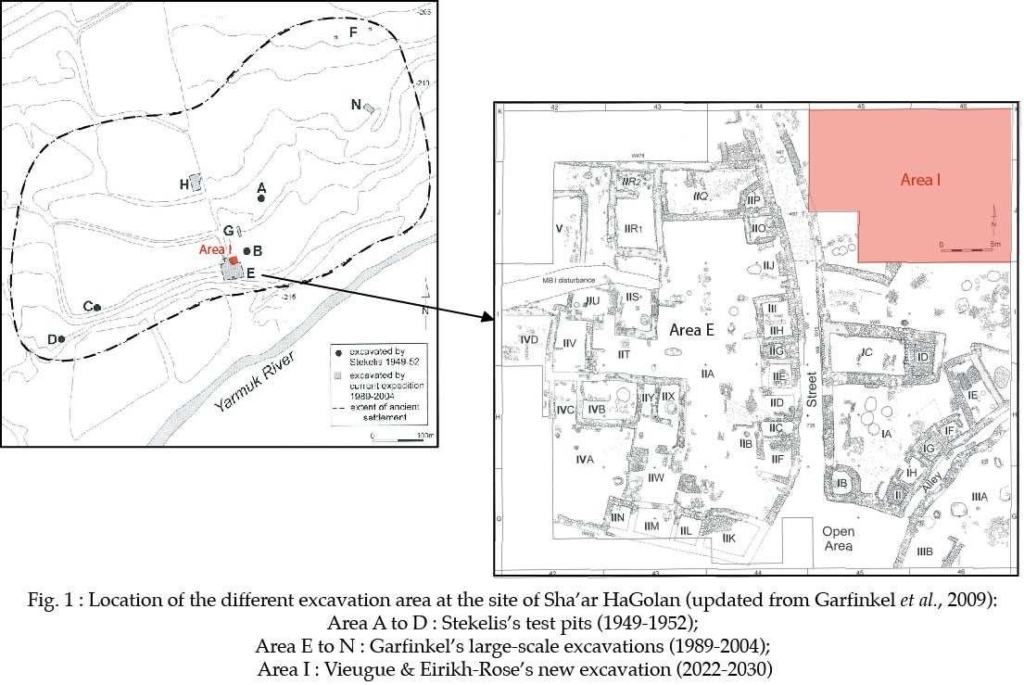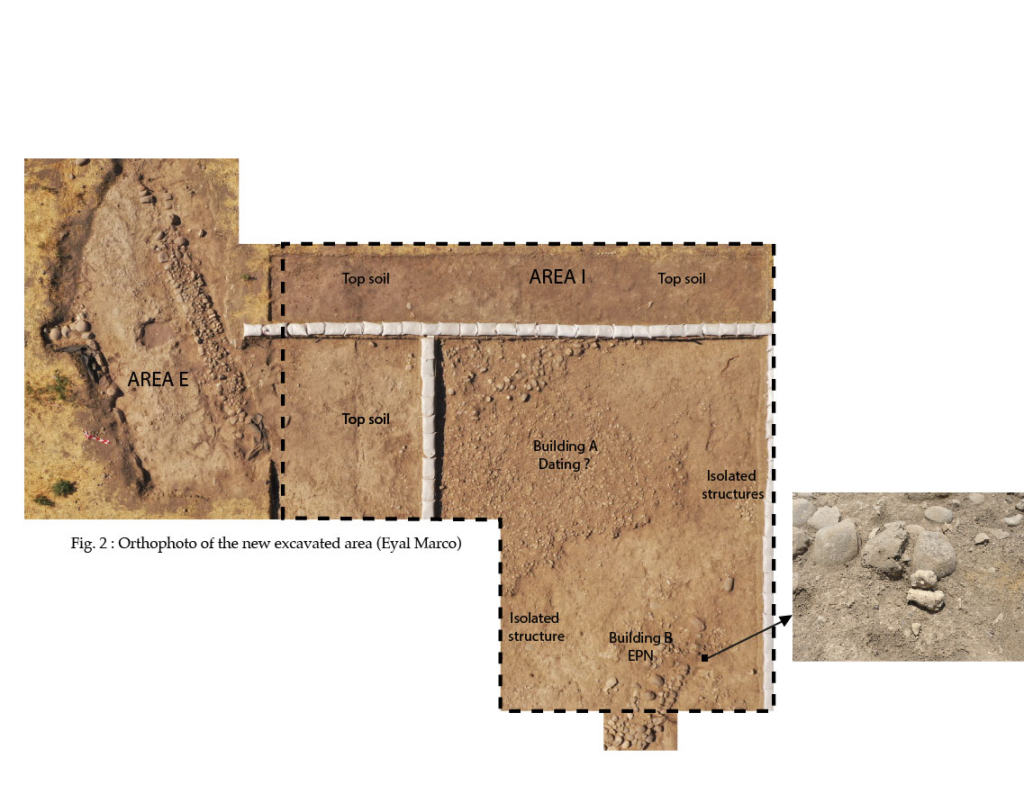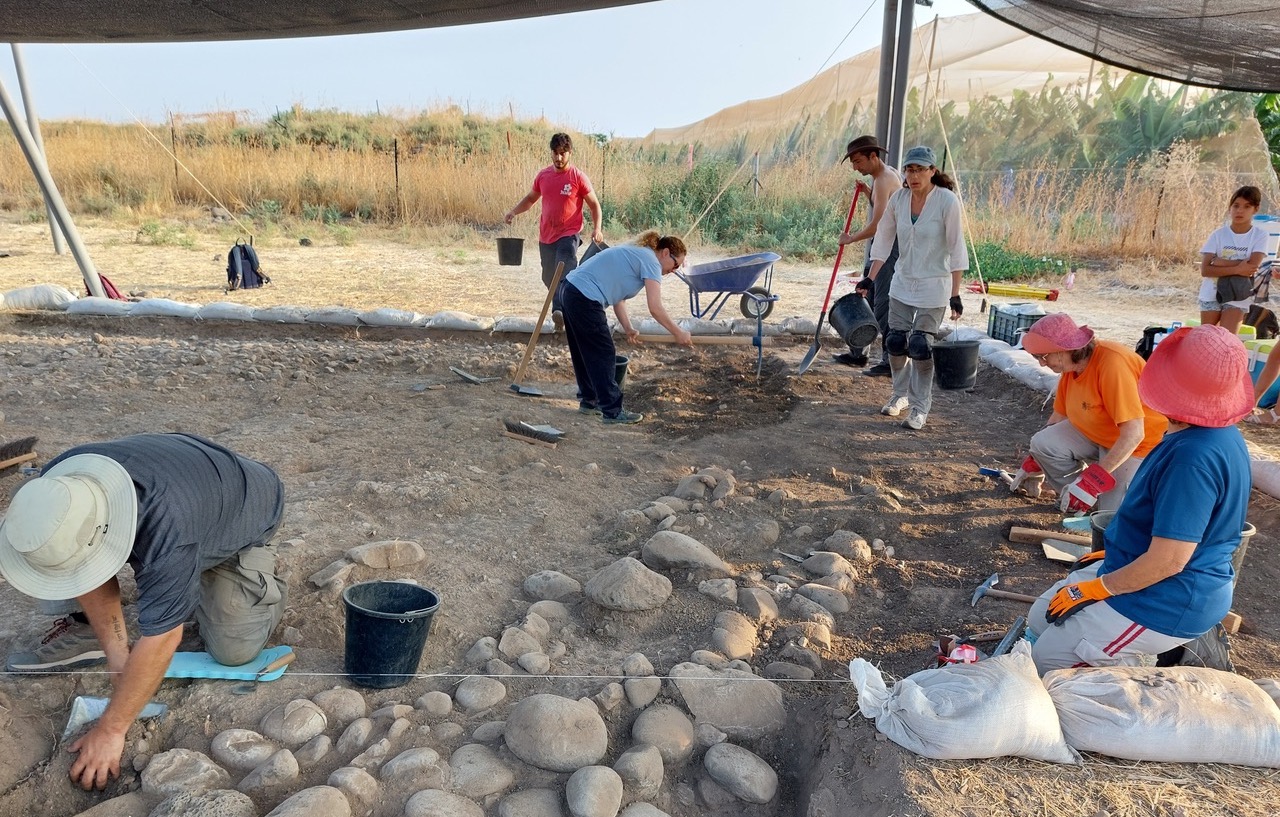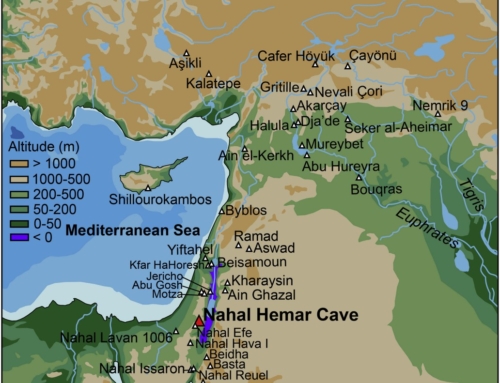Sha’ar Hagolan et la seconde Révolution Néolithique au Proche Orient (7ème millénaire av. J.-C.)
Institutional framework: A French-Israeli joint excavation project
The French-Israeli joint excavation project conducted at the site of Sha’ar HaGolan is carried out within the framework of a triple partnership between the laboratory “Technology and Ethnology of Prehistoric Worlds” (TEMPS, France), the French Research Centre in Jerusalem, (CRFJ) and the Israel Antiquities Authority (IAA, Israel). It is affiliated to a field school coordinated by the Balkan Heritage Foundation (BHF, Bulgaria) (see: https://www.bhfieldschool.org/program for more details). The field investigations are co-directed by Julien Vieugué (researcher at the CNRS) and Anna Eirikh-Rose (researcher at the IAA) who collaborate for 5 years on the Neolithic transition of the Near East. They are carried out by an international and multidisciplinary team made up of 13 scholars who are affiliated to 11 different research institutions.
Historical issues: Understanding better the definitive shift of the Levantine societies towards a fully developed Neolithic way of life
The French-Israeli joint excavation project conducted at the site of Sha'ar HaGolan aims at better understanding the definitive shift of Levantine societies towards a fully developed Neolithic way of life (the so-called “Second Neolithic Revolution)” that occurred during the 7th millennium cal. BC. In order to shed new light on this pivotal period, we will question:
- The major social changes linked to the emergence of the first villages structured into neighborhoods and streets. Why did this change occur? What impact has it had on the social organisation of the Neolithic communities?
- The significant economic changes characterized by the emergence of pottery and the development of pastoralism. Why did the populations of the southern Levant start to use ceramic vessels? Did they use them to store, transport, prepare, cook and consume the various animal and plant substances coming from intensive farming? Is there a link between the widespread adoption of pottery and the development of pastoralism during the PPN-PN transition?
- The major symbolic changes characterized by the scarcity of the human burials and the increase of the anthropomorphic figurines. What did the populations of the Southern Levant do with their dead? Did they bury them outside the village or cremate them? What did the clay and stone figurines represent? Were they the symbol of ancestors and mother goddess cult? Is there a link between the disappearance of skeletons and the appearance of human figurines during the PPN-PN transition?
Because it has a unique stratigraphic sequence (2m thick) covering the entire 7th millennium cal. BC, the eponymous village of Sha'ar HaGolan proves to be a key site to better understand the historical processes which led to the full development of the Neolithic way of life.
Sha’ar HaGolan: A major Neolithic village in the Near East
Covering an area of 20 hectares, Sha'ar HaGolan is one of the largest Neolithic villages in the Near East. The site, located in the upper Jordan Valley, was discovered in 1941 by Yehuda Ruth and Motik Golani while digging fish ponds. Between 1949 and 1952, Moshe Stelekis (Professor at the Hebrew University of Jerusalem) carried out four test pits (A, B, C and D - 155 m2). He uncovered a unique material culture that he then defined as the Yarmukian culture. Between 1989 and 2004, Yosef Garfinkel (Professor at the Hebrew University of Jerusalem) carried out the spatial excavation of the last Yarmukian occupation phase (Area E, H, F, N - 2775 m2). He uncovered real living quarters separated by streets, upsetting our knowledge regarding the way of life of the Levantine societies during the second half of the 7th millennium cal. BC which were then thought to be nomadic. At the end of the project, a deep sounding (Area G - 100 m2) was carried out in order to know the actual duration of occupation at this open-air settlement. The excavation highlighted a unique 2m thick stratigraphic sequence covering the whole 7th millennium cal. BC. In 2022, Julien Vieugué (researcher at the CNRS) and Anna Eirikh-Rose (researcher at the IAA) undertook the stratigraphic excavation of the multiple preserved Neolithic occupation layers at the site (Area I) in order to better understand the PPN-PN transition in the Near East (6600-6200 cal. BC) (Fig. 1).

Excavation strategy: A palaethnographic approach
In order to reach our goal, we opened a new excavation area (Area I) within the protected area of the site which is under the supervision of the Israel Antiquities Authority. This new excavation area is located alongside the north-east corner of the previous excavation area (Area E) excavated by Yosef Garfinkel. With an estimated total surface of 200m2, it is precisely located east of the main street and north of the building complex 1 of Area E. The new excavation area appears ideal for uncovering a new living quarter and following its evolution throughout the 7th millennium cal. BC. Indeed, the remains of at least one multi-occupied building complex were likely preserved there, given the presence of a massive multi-phased stone-foundation wall that was partially excavated in Area E and clearly continued into Area I.
The field investigations are carried out following the principles of palaethnographic approach laid down by André Leroi-Gourhan. This approach consists of uncovering the successive occupation phases of a Neolithic settlement, by meticulously clearing the various remains that litter the prehistoric floors. In order to accurately document the chrono-stratigraphic sequence at the site, we opted for a recording system by Stratigraphic Units (US). This system, widely used for the excavation of multi-phased urban sites, seems particularly well suitable for the analysis of complex stratified Neolithic settlements. The various Stratigraphic Units that make up the sequence were identified on the basis of sedimentary differences and/or concentrations of artefacts. Each refers to a particular natural and/or anthropogenic event, such as the construction of a stone-foundation wall, the collapse of a mudbrick wall, the construction of a dwelling floor or the homogeneous filling of a waste pit.
L’équipe scientifique :
The project is led by an international and multidisciplinary team made up of 13 scholars, including 6 field archaeologists, 2 topographers, 2 curators and restorers, 1 micro-morphologist, 1 physical anthropologist and 1 museum manager. The field archaeologist specialized in Neolithic architecture and the micro-morphologist will together seek to better understand the emergence of the first Neolithic villages structured in living quarters during the 7th millennium cal. BC; The physical anthropologist and the field archaeologist specialized in Neolithic art will together seek to clarify the intriguing phenomenon of the scarcity of human burials and the increase of anthropomorphic figurines during the PPN-PN transition.
First Results: the 2022 excavation season
A first excavation season, funded by the French Research Center in Jerusalem (CNRS, UMIFRE 7) and the Israel Antiquities Authority (IAA), was carried out from 12th to 24th June 2022 (that is 2 weeks) in order to establish the new excavation area (Area I) and uncover the last Yarmukian occupation layer preserved in this part of the open-air settlement. Field research has led to the discovery of two exceptionally well-preserved buildings, including one clearly dated to the Early Pottery Neolithic due to the presence of artefacts that are typical of the Yarmukian culture (Fig. 2). This building, uncovered in the south-east corner of Area I, faces south-west/north-east. It is made up of a stone-foundation wall associated with the remains of a stone floor and a plastered structure. In addition to dozens of potsherds and flint tools, a complete anthropomorphic figurine of about twenty centimeters was found leaning against the east face of the wall. The discovery of such remains in a primary position proves the excellent preservation of the archaeological layers dated of the 7th millennium cal. BC in this part of the open-air settlement.

References:
Eirikh-Rose A. and Garfinkel Y. 2002 The pottery. In: Garfinkel Y. and Miller M. (eds.), Sha’ar Hagolan I. Neolithic Art in Context: 86-138. Oxford: Oxbow Books.
Eirikh-Rose A. and Vieugué J. (2022) – 8000-year-old Yarmukian « Mother Goddess » figurine uncovered at Sha’ar HaGolan. Interviewé par Judith Sudilovsky. Publié au Jerusalem Post. https://www.jpost.com/archaeology/article-711462
Garfinkel Y. 1993 The Yarmukian Culture in Israel. Paléorient 19,1: 115-134.
Garfinkel Y. and Ben-Shlomo D. 2009. Sha’ar Hagolan II – The rise of urban concepts in the Ancient Near East. Jerusalem: Israel Exploration Society (Qedem Reports 9).
Garfinkel Y. and Miller M.A. 2002 Sha’ar Hagolan I: Neolithic Art in Context. Oxford: Oxbow Books.
Garfinkel Y., Ben-Shlomo D. and Korn N. 2010 Sha’ar Hagolan III. Symbolic dimensions of the Yarmukian Culture: canonization in Neolithic art. Jerusalem: Israel Exploration Society.
Garfinkel Y., Ben-Shlomo D. and Marom N. 2012 Sha’ar Hagolan: a major pottery Neolithic settlement and artistic center in the Jordan Valley. Eurasian Prehistory 8,1: 97-143.
Rosenberg D. and Garfinkel Y. 2014 Sha’ar Hagolan IV: The Ground-Stone Industry: Stone working at the dawn of pottery production in the Southern Levant. Jerusalem: the Hebrew University of Jerusalem (Israel Exploration Society 29).
Vieugué J, Eirikh-Rose A., Whitford B., Boyadzhiev K., Harivel C., Marco E., Tzur M. (2023) – Sha’ar Hagolan and the Second Neolithic Revolution in the Near East. Report n°1 of the 2022 excavation season. 24p.












